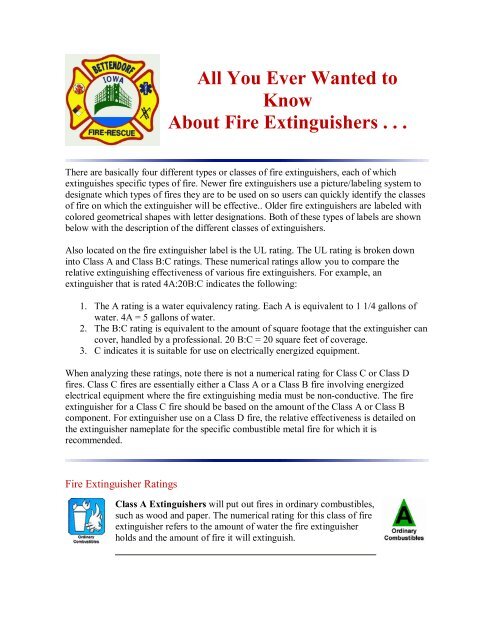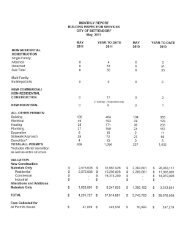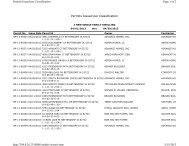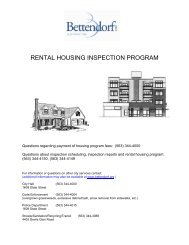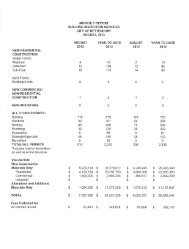All You Ever Wanted to Know About Fire Extinguishers . . .
All You Ever Wanted to Know About Fire Extinguishers . . .
All You Ever Wanted to Know About Fire Extinguishers . . .
You also want an ePaper? Increase the reach of your titles
YUMPU automatically turns print PDFs into web optimized ePapers that Google loves.
<strong>All</strong> <strong>You</strong> <strong>Ever</strong> <strong>Wanted</strong> <strong>to</strong><strong>Know</strong><strong>About</strong> <strong>Fire</strong> <strong>Extinguishers</strong> . . .There are basically four different types or classes of fire extinguishers, each of whichextinguishes specific types of fire. Newer fire extinguishers use a picture/labeling system <strong>to</strong>designate which types of fires they are <strong>to</strong> be used on so users can quickly identify the classesof fire on which the extinguisher will be effective.. Older fire extinguishers are labeled withcolored geometrical shapes with letter designations. Both of these types of labels are shownbelow with the description of the different classes of extinguishers.Also located on the fire extinguisher label is the UL rating. The UL rating is broken downin<strong>to</strong> Class A and Class B:C ratings. These numerical ratings allow you <strong>to</strong> compare therelative extinguishing effectiveness of various fire extinguishers. For example, anextinguisher that is rated 4A:20B:C indicates the following:1. The A rating is a water equivalency rating. Each A is equivalent <strong>to</strong> 1 1/4 gallons ofwater. 4A = 5 gallons of water.2. The B:C rating is equivalent <strong>to</strong> the amount of square footage that the extinguisher cancover, handled by a professional. 20 B:C = 20 square feet of coverage.3. C indicates it is suitable for use on electrically energized equipment.When analyzing these ratings, note there is not a numerical rating for Class C or Class Dfires. Class C fires are essentially either a Class A or a Class B fire involving energizedelectrical equipment where the fire extinguishing media must be non-conductive. The fireextinguisher for a Class C fire should be based on the amount of the Class A or Class Bcomponent. For extinguisher use on a Class D fire, the relative effectiveness is detailed onthe extinguisher nameplate for the specific combustible metal fire for which it isrecommended.<strong>Fire</strong> Extinguisher RatingsClass A <strong>Extinguishers</strong> will put out fires in ordinary combustibles,such as wood and paper. The numerical rating for this class of fireextinguisher refers <strong>to</strong> the amount of water the fire extinguisherholds and the amount of fire it will extinguish.
Class B <strong>Extinguishers</strong> should be used on fires involvingflammable liquids, such as grease, gasoline, oil, etc. The numericalrating for this class of fire extinguisher states the approximatenumber of square feet of a flammable liquid fire that a non-expertperson can expect <strong>to</strong> extinguish.Class C <strong>Extinguishers</strong> are suitable for use on electricallyenergized fires. This class of fire extinguishers does not have anumerical rating. The presence of the letter “C” indicates that theextinguishing agent is non-conductive.Class D <strong>Extinguishers</strong> are designed for use on flammable metalsand are often specific for the type of metal in question. There is nopicture designa<strong>to</strong>r for Class D extinguishers. These extinguishersgenerally have no rating nor are they given a multi-purpose ratingfor use on other types of fires.Class K <strong>Extinguishers</strong> are used on fires involving cooking media(fats, grease, and oils) in commercial cooking sites such asrestaurants. These fire extinguishers work on the principle ofsaponification. Saponification takes place when alkaline mixtures,such as potassium acetate, potassium citrate, or potassiumcarbonate, are applied <strong>to</strong> burning cooking oil or fat. The alkalinemixture combined with the fatty acid creates a soapy foam on thesurface that holds in the vapors and steam and extinguishes the fire.These extinguishers are identified by the letter K.are designed for use on flammable metals and are often specific forthe type of metal in question.Multi-Class Ratings
This is the new style of labeling that shows thisextinguisher may be used on Ordinary Combustibles,Flammable Liquids, or Electrical Equipment fires.This is the new labeling style with a diagonal red linedrawn through the picture <strong>to</strong> indicate what type offire this extinguisher is NOT suitable for. In thisexample, the fire extinguisher could be used onOrdinary Combustibles and Flammable Liquids fires,but not for Electrical Equipment fires.Types of <strong>Fire</strong> <strong>Extinguishers</strong>Dry Chemical extinguishers are usually rated for multiple purpose use. Theycontain an extinguishing agent and use a compressed, non-flammable gas as apropellant.Halon extinguishers contain a gas that interrupts the chemical reaction that takesplace when fuels burn. These types of extinguishers are often used <strong>to</strong> protectvaluable electrical equipment since them leave no residue <strong>to</strong> clean up. Halonextinguishers have a limited range, usually 4 <strong>to</strong> 6 feet. The initial application ofHalon should be made at the base of the fire, even after the flames have beenextinguished.Water These extinguishers contain water and compressed gas and should onlybe used on Class A (ordinary combustibles) fires.Carbon Dioxide (CO2) extinguishers are most effective on Class B and C(liquids and electrical) fires. Since the gas disperses quickly, these extinguishersare only effective from 3 <strong>to</strong> 8 feet. The carbon dioxide is s<strong>to</strong>red as a compressedliquid in the extinguisher; as it expands, it cools the surrounding air. The coolingwill often cause ice <strong>to</strong> form around the “horn” where the gas is expelled from theextinguisher. Since the fire could re-ignite, continue <strong>to</strong> apply the agent even afterthe fire appears <strong>to</strong> be out.
How <strong>to</strong> Use a <strong>Fire</strong> ExtinguisherEven though extinguishers come in a number of shapes and sizes, they all operate in a similarmanner. Here's an easy acronym for fire extinguisher use:P A S S -- Pull, Aim, Squeeze, and SweepPull the pin at the <strong>to</strong>p of the extinguisher thatkeeps the handle from being accidentallypressed.Aim the nozzle <strong>to</strong>ward the base of the fire.Stand approximately 8 feet away from thefire and squeeze the handle <strong>to</strong> discharge theextinguisher. If you release the handle, thedischarge will s<strong>to</strong>p.Sweep the nozzle back and forth at the baseof the fire and slowly move forward <strong>to</strong>extinguish the remaining fire. After the fireappears <strong>to</strong> be out, watch it carefully since itmay re-ignite!Congratulations -- you did it!!!LocationThe International <strong>Fire</strong> Code and OSHA require that owners/employers select and distribute fireextinguishers based on the classes of anticipated workplace fires and also on the size and degreeof the hazard that would affect their use. The following chart contains requirements for classesof fires and travel distance <strong>to</strong> an extinguisher.
<strong>Fire</strong> ClassClass ATravel Distance75 feet (22.9 m) or lessClass B 50 feet (15.2 m)Class CClass DClass KBased on appropriate A or B Hazard75 feetWithin 30 feet of commercial cooking equipment<strong>Extinguishers</strong> need <strong>to</strong> be conspicuously located and available in the case of fire. They alsoshould be located along normal paths of travel and near exits. Portable fire extinguishers thatare not wheeled should be installed on the hanger or bracket supplied or placed in cabinets orwall recesses.The locations of fire extinguishers must be identified so they are readily available <strong>to</strong> employeeswithout subjecting them <strong>to</strong> injury. Height requirements for mounting extinguishers depend onthe weight of the unit. If the unit weighs less than 40 pounds, it should be installed so the <strong>to</strong>p ofthe extinguisher is no more than 5 feet above the floor. If the unit weighs more than 40 pounds,it should be installed so the <strong>to</strong>p of the extinguisher is no more than 3.5 feet above the floor. Atno point should the extinguisher be less 4 inches from the floor.TrainingWhere the employer has provided fire extinguishers for employee use, the employer mustprovide an educational program <strong>to</strong> familiarize employees on the principles and use of theextinguishers. This educational program should be completed during the initial hiring andannually thereafter.InspectionsPortable fire extinguishers must be visually inspected monthly. The inspection should assurethat:1. <strong>Fire</strong> extinguishers are in their assigned place;2. <strong>Fire</strong> extinguishers are not blocked or hidden;3. <strong>Fire</strong> extinguishers are mounted in accordance with NFPA Standard No. 10 (Portable<strong>Fire</strong> <strong>Extinguishers</strong>);4. Pressure gauges show adequate pressure (a CO 2 extinguisher must be weighed <strong>to</strong>determine whether leakage has occurred);5. Pin and seals are in place;6. <strong>Fire</strong> extinguishers show no visual sign of damage or abuse;7. Nozzles are free of blockage.Maintenance, inspection, and testing of an extinguisher are the responsibility of the employer.Maintenance should be done at least annually or more often if conditions warrant. Theemployer shall record the annual maintenance date and keep these records for one year after therecorded date or the life of the shell of the extinguisher.
Hydrostatic testing of portable fire extinguishers is done <strong>to</strong> protect against unexpected inservicefailure. This can be caused by internal corrosion, external corrosion, damage fromabuse, etc. Hydrostatic testing must be performed by trained personnel with proper testequipment and facilities. OSHA requires hydrostatic testing according <strong>to</strong> the schedule listed in29 CFR 1910.157 Table L-1.<strong>Fire</strong> extinguishers, correctly used on the type of fire they are intended for, can have a large rolein s<strong>to</strong>pping major fire damage and dollar losses. However, it should be noted that it may not bepossible <strong>to</strong> extinguish every fire with fire extinguishers. When personal safety is in jeopardy,personnel should not attempt <strong>to</strong> extinguish the fire but should evacuate the building. In allinstances, the fire department should be called immediately if a fire occurs.


